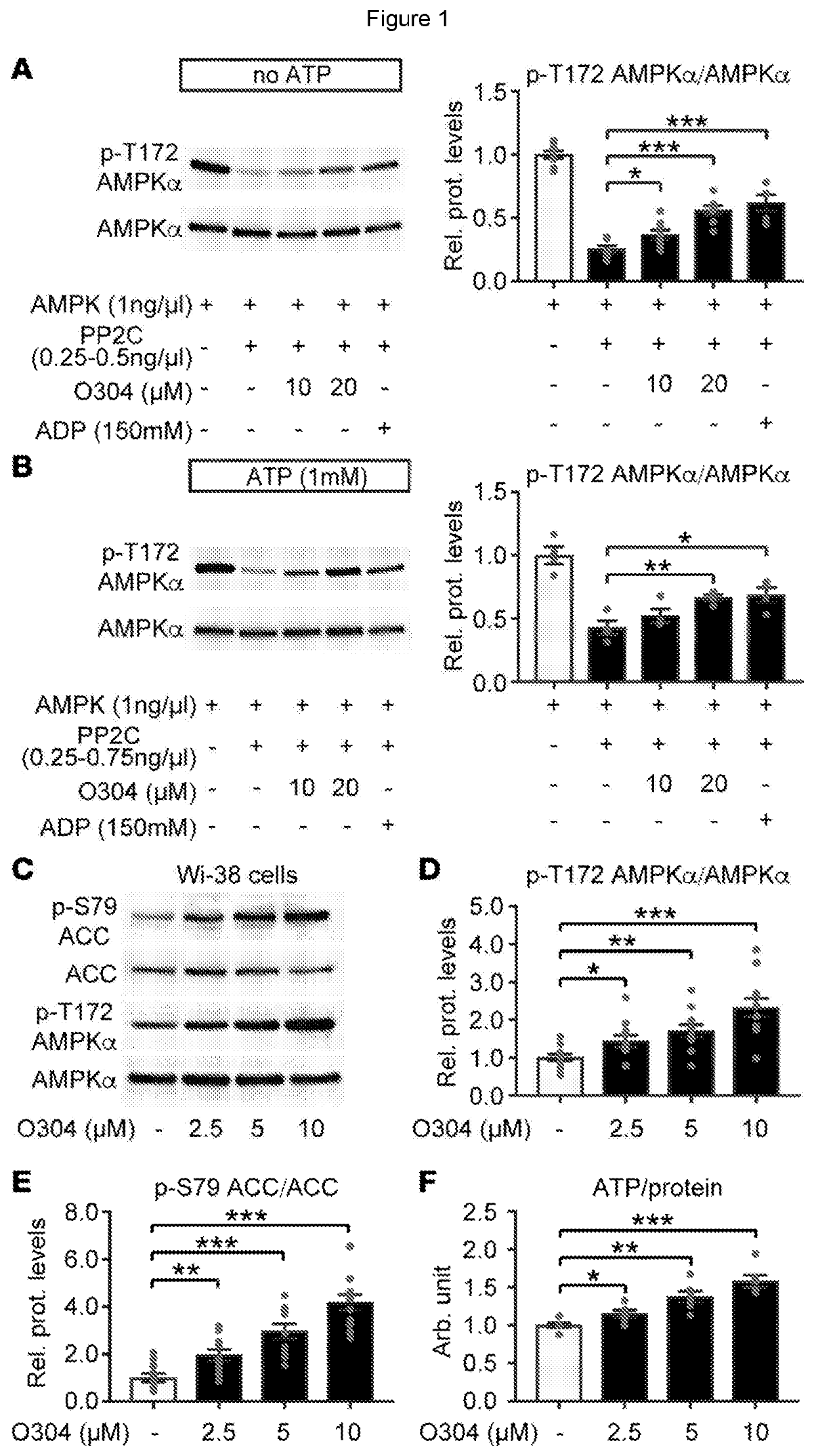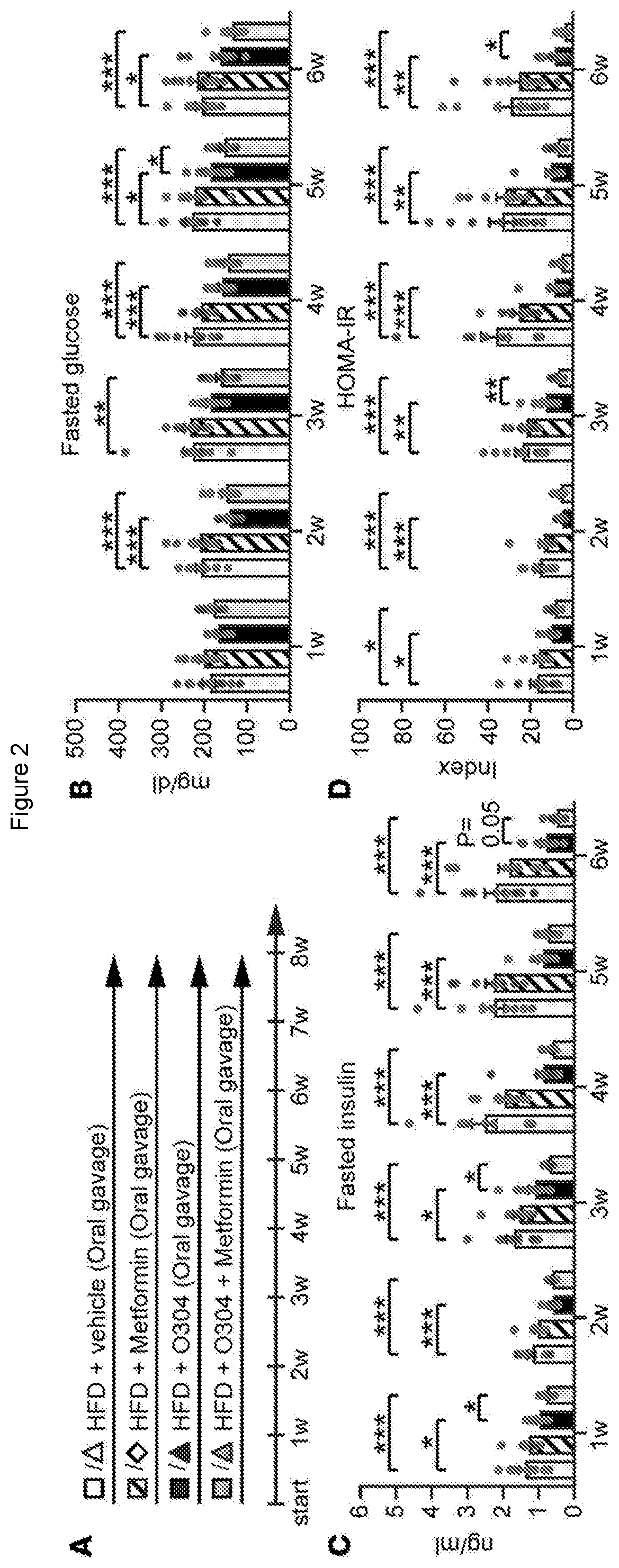Methods Of Treating Diabetes In Severe Insulin-Resistant Diabetic Subjects
a technology of severe insulin resistance and diabetes, applied in the field of diabetes treatment methods, can solve the problems of no definitive cure, excess mortality and cardiovascular morbidity remain a considerable challenge for healthcare systems, and the loss of limbs, so as to improve the survival rate of diabetic kidney disease, improve the effect of microvascular perfusion, and improve the effect of blood glucose control
- Summary
- Abstract
- Description
- Claims
- Application Information
AI Technical Summary
Benefits of technology
Problems solved by technology
Method used
Image
Examples
example 1
[0092]We here describe the identification and testing of a PAN-AMPK activator, referred to as the test material, which was found to increase AMPK activity by suppressing the dephosphorylation of pAMPK.
[0093]Methods
[0094]Study Design
[0095]For animal experiments, no sample-size estimate was calculated before the study was executed. The experiments were not randomised unless otherwise stated. Investigators were not blinded to allocation during experiments and outcome assessment except during some measurements and quantifications (glucose tolerance test, glucose stimulated insulin secretion, arginine stimulation of insulin secretion, amyloid quantification, echocardiography, and ultrasound examination of the heart). For in vivo data, each n value corresponds to a single mouse. For amyloid quantification each n value corresponds to independent experiments and total number of islets investigated, respectively. For in vitro data, each n value corresponds to an independent experiment. If te...
example 2
[0187]Methods
[0188]Clinical Study Design
[0189]An exploratory proof-of-concept randomised, parallel-group, double-blinded, placebo-controlled phase IIa 28-day study (TELLUS) of the first-in-class AMPK activator (the test material; 1,000 mg / day) was conducted in 65 T2D patients on Metformin for months, aiming at further exploring safety of test material and the effect of test material on FPG at a single-dose level.
[0190]TELLUS is listed in the EudraCT database protocol no. 2016-002183-13. The study was performed in accordance with ethical principles that have their origin in the Declaration of Helsinki and are consistent with International Conference of Harmonization (ICH) / Good Clinical Practice (GCP), European Union (EU) Clinical Trials Directive, and applicable local regulatory requirements. The study protocol was approved by the Regional Ethics Committee in Uppsala, Sweden, Project no / ID 0304-2016-02. Before performing any study-related procedures an informed consent ...
example 3
vator+SGLT2 Inhibitor
[0212]Test Compound
[0213]The test materials used in this study were:
[0214](A) 4-chloro-N-[2-[(4-chlorophenyl)methyl]-3-oxo-1,2,4-thiadiazol-5-yl]benzamide (referred to herein as “Compound 1”), synthesised and purified by Anthem Biosciences Pvt. Ltd. (Bangalore, India); and
[0215](B) Canagliflozin.
[0216]Animals and Husbandry
[0217]Male C57BL / 6J mice, 8 weeks of age were purchased from Jackson, Charles River Laboratories, Inc. (Germany). All animals were housed in the Umeå University animal facility (Umeå Centre for Comparative Biology; UCCB) with a 12:12 hour light-dark cycle (lights on at 6 a.m.) and a constant temperature of 21° C. The animals were ear marked with a unique identification number, and groups of 5 mice were housed in transparent polycarbonate cages that comply with the requirements of the Code of Practice for the housing and care of animals used in scientific procedures. Wood chips were used as bedding material and environmental enrichment was provi...
PUM
| Property | Measurement | Unit |
|---|---|---|
| Mass | aaaaa | aaaaa |
| Molar density | aaaaa | aaaaa |
| Concentration | aaaaa | aaaaa |
Abstract
Description
Claims
Application Information
 Login to View More
Login to View More - R&D
- Intellectual Property
- Life Sciences
- Materials
- Tech Scout
- Unparalleled Data Quality
- Higher Quality Content
- 60% Fewer Hallucinations
Browse by: Latest US Patents, China's latest patents, Technical Efficacy Thesaurus, Application Domain, Technology Topic, Popular Technical Reports.
© 2025 PatSnap. All rights reserved.Legal|Privacy policy|Modern Slavery Act Transparency Statement|Sitemap|About US| Contact US: help@patsnap.com



